Newsletter No.51


Two of the Central Committee Members (Yang Chor Leong and A Aziz Y Kamaruddin) were chosen as international resource persons at the Fourth Regional Quality Convention organised by the Nepal AOTS Alumni Society. It was held at Kathmandu, Nepal from 27th-29th July 2006. It was a very successful Convention, and excellently organised. With their “Can do!” positive attitude, seeing the Nepal AOTS Alumni Society organising the Convention was an inspiring occasion for all the international resource persons. If all of us in the Persatuan have a “Malaysia Boleh!” attitude, I am sure that we can host the next World Convention of Alumni Societies (in 2010).
Eleven (11) of the Persatuan members will be attending the 7th World Convention to be held from 11th-12th September 2006 at Mumbai, India. We will be offering Malaysia to host the next World Convention, and the big delegation is to assist with our promotional efforts to sell Malaysia as a great place to host the next World Convention. We are also getting assistance from the Tourism Malaysia offices in Kuala Lumpur and Mumbai to provide some souvenirs for the Mumbai Convention. We thank Tourism Malaysia for their kind cooperation.
As always, we also look forward to feedback from all of you on how to further improve our activities.
Wishing GOOD HEALTH to you and your family and SUCCESS in all your undertakings!
A. AZIZ Y. KAMARUDDIN
PRESIDENT
(azizyoup@gmail.com)
4th. Regional Quality Convention (4th. RQC)
Katmandu – Nepal .
27th to 29th July 2006
by : CL Yang
Namaste,
We are honored and privileged to be invited as one of the International Resource Persons to speak on “Improving Competitiveness through Quality in the Globalized Regime ” at the 4 th RQC by AOTS Nepal.
The event was also to mark the 50 th Anniversary of the establishment of Nepal-Japan diplomatic and cordial relations. AOTS Alumni Nepal has been playing an important role of contributing and strengthening to this relationship, while pursuing this objective of human resource development in Nepal.
At the convention, representatives from 9 countries of the Asia Pacific Region which are Japan, Philippines, Singapore, Bangladesh, Pakistan, Iran, Malaysia, India and the host country Nepal shared their experiences.
The highlight of the convention was the presence of the eminent Quality Guru, Professor Noriaki Kano from Japan who delivered the keynote address. The convention attracted more than 250 participants and guests, witnessed by the Deputy Prime Minister and the Japan’s Ambassador to Nepal.
Some of the papers presented at the convention were:
• Business Strategy for performance excellent through TQM
• Quality Assurance for customers delight and satisfaction
• QC circles activities and Employees Empowerment
• ISO standard integration and implementation
• Social responsibilities and environment management
• Quality management in Health and Medicine
• New product development and Products Innovation
The 3-day convention was concluded with a stronger network of friendship among all the alumni societies in the region being forged, thus further strengthening the tie between Nepal and Japan in particular, and Nepal and the world in general.
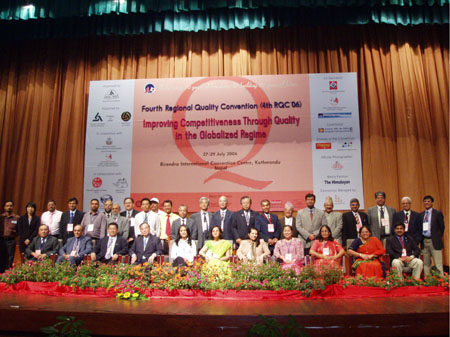 Group photo of the Internationl Resource person & VIP | |
| 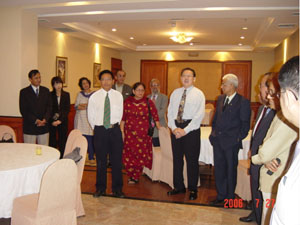 Getting-to-know-you between international & Nepalese resource |
Now, let me share my personal experience with all of you on the interesting places in this beautiful country- Nepal. The capital city Katmandu, is a melting pot of various nationalities and cultures. The people enjoy a rich heritage of unique architectural palaces, temples and courtyards.
It boasts a unique symbiosis of Hinduism, Buddhism as well as Tantrism. The effect of these religious influences could be openly seen in the city.
The most ancient and enigmatic of all is the Valley’s holy shrines which lie west of Katmandu known as ” Swayambhunath Stupa ” – is a world heritage site. The golden spine crowns a wooden hillock offers a commanding view of the city.
In contrast, a hill resort called Pokhara which is located 200 KM west of Katmandu is a remarkable place of nature beauty, commonly known as ” Switzerland of the East ” .
The enchanting city at an altitude of 827 meters from the sea level has several beautiful lakes and offer stunning panaromic view of the Himalayan Peaks. If you are lucky on a clear day you can have a good view of Mount Everest. The serenity of lakes and the magnificence of the Himalaya rising behind them create an ambience of peace and magic
It is truly a memorable experience for me to have the opportunity touring the country and to attend and share our experiences at the convention and meeting other AOTS Alumni members.
My heart felt gratitude to the great host, Nepal AOTS Alumni Society (NAAS) for their warm hospitality extended to us throughout our stay.
 At the village of tomatoes farm | 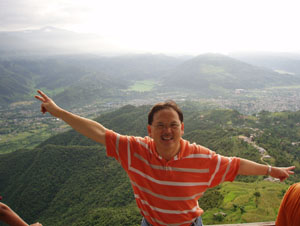 At Pokhara Mount |
| Training Course on Equipment Maintenance: How to Implement Autonomous Equipment Maintenance in Subang Jaya on 19-20 June 2006 | |
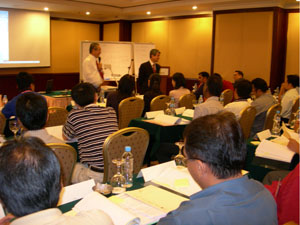 |
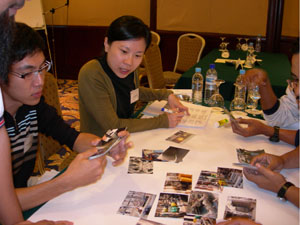 |
|
Training Course on Equipment Maintenance:
How to Implement Autonomous Maintenance Activities
in Johor Bahru on 22-23 June 2006 |
|
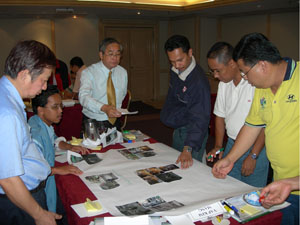 |
 |
Journal part5
Hippo Participant’s experience
By : Nurussaadah Mokhtar
Day 5: Thursday, June 2, 2005
I only get to know the existence of Kobe in Japan from its earthquake which happened in 1995. On the fifth day of my visit to Japan, Kobe was the destination.
I have met another friend, Nancy who teaches Japanese voluntarily. Together with Sanae-chan and Koh-chan whom I met earlier in Hippo gathering, they planned for sightseeing in Kobe Harbourland. ‘So this is the world of globalization popped out of my mind when they introduced Adil, a Palestinian man and who used to stay in Europe for few years. In a big restaurant in the Harbourland, we had a wonderful seafood and chatted for hours. That one whole day was not enough for us to get to know each other. Great!
After a few days, I became very impatient for dinner prepared by Rina-chan… Incredible huh? Every dinner with both Rina-chan and Hirooki-chan would be a one very long and we became more attached to each other as we shared different opinions but similar hopes in life. That particular day, Rina-chan mentioned that she is going to miss me when I have to leave soon.
 With Nancy and Koh-chan while waiting for a train at Shukugawa Station |  With Nancy and Adil as we reached Kobe Harbourland. |
Day 6: Friday, June 3, 2005


Friday in Japan? How would it be? Friday in Malaysia means long lunch hour, men going for Friday prayers and supermarkets filled with women fulfilling their ‘needs’.
Early in the morning, I joined Miifa, Margarita and Pure for ceramic making. We went to a house of a sensei who teaches ceramic making. He has been teaching Miifa and Pure before. Ironically, I never had a chance to make ceramic in Malaysia. I couldn’t believe that I got to do it in Japan instead!
After that, we got on train to Kobe for Friday prayer. Nana, Azah, Rina-chan and Nancy were already waiting for us at the Kobe Mosque.
As we were walking into the mosque, suddenly somebody from behind greeted salam to me. Wow… it has been a while I did not hear people giving salam while in Japan. His name is Jonni, he was on his way to the mosque too. Jonni comes from Indonesia and now undertaking a practical training in Japan.

We have met a few Muslims from Pakistan, Bangladesh Indonesia and Japanese too. We were introduced to Lutfi who comes from Bali. He spoke fluent Japanese as he has been staying in Japan for almost a year!
We had buffet lunch of Indian food which I thought had a blend of Middle Eastern food too. The yogurt drink was awesome! That kind of lunch cost us ¥ 500! No wonder the restaurant owner smiled happily as we left the place.
On our way back home, I presumed that Rina-chan already started to plan what to cook that night. I did pity her. When I was organizing my things in their cozy reading room, Rina-chan called me several times to the kitchen to choose which flavor can be eaten or not. Most of the time I would say ‘gomen nasai’ which means ‘sorry’ to trouble her that way. She responded and said ‘daijeboo’ which means ‘never mind’. Of course, that was the way to treat a visitor, right?
 |  |
Miifa and Pure joined us in Friday prayer at the mosque. | Waiting in a long queue for the Indian Restaurant near the mosque; from left, a Bangladeshi studying Japanese, Miifa, Nancy, Azah, me, Nana and Lutfi. Man, we were starving! |
 | |
That smile is the satisfaction of the ¥ 500 lunch I guess! | |
Climatically Japan is a country with four distinct seasons, and many annual events are associated with the changing of the seasons
New Year
The Japan celebrate the passing of one year the arrival of the next with great fervor. The period of celebration is called shogatsu, which in its broadest sense refers to the first month of the year.
On January 1 families gather to drink a special kind of sake that is supposed to ensure a long life, eat a special kind of soup containing glutinous rice cakes, and generally wipe away any bitter memories remaining from the previous year. People decorate the entrances to their homes with branches of pine and with straw festoons, which symbolically prevent the entrance of anything impure. They also visit shrines to pray for good fortune in the coming year and the homes of relatives and friends to exchange New Year’s greetings Nowadays many children spend the holidays engrossed in computer games, but there are skill battledore, spinning tops, kites, and sugoroku, Japanese version of Parcheesi. The New Year’s celebration is the biggest event on the calendar in Japan, and all companies and government offices are closed for the first days of the year.
Setsubun

In the past the word setsubun referred to any of the many seasonal changes on the old calendar, but now it refers specifically to February 3 or 4, the traditional beginning of spring. On the old calendar the first day of spring marked the start of the new year, and the preceding day or setsubun, represented the final day of the old year. The traditional way of celebrating this day is by scattering beans about the home to ward off evil spirits.
Doll Festival
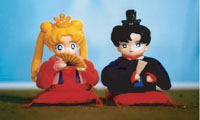
The Doll Festival, or hina matsuri, takes place on March 3. Families with girls display a set of dolls representing the ancient imperial court and celebrate by drinking a special kind of sweetened white sake.
Children’s Day
The fifth day of the fifth month has been celebrated in China and Japan since ancient times. In Japan May 5 was made a national holiday in 1948. Though it is called Children’s Day, this festival is really only for boys. Families with boys hang streamers depicting carp outside their homes as symbols of strength, display samurai dolls and armor inside, and celebrate by eating special rice cakes.
Bon Festival
The Bon Festival traditionally took place for several days around July 15 on the lunar calendar, when the souls of the dead are believed to return to their homes. These days it is usually held around August 15. Many people make trips back to their hometowns at this time of the year to visit the graves of relatives. During this festival people set up lanterns to guide the souls of the dead to and from their homes, make offerings of food to the deceased, and enjoy a special kind of dancing called bon odori. The lanterns are often floated down rivers.
Tanabata Festival
Celebrated on July 7, or in some places on August 7, the Tanabata Festival has its origins in a Chinese folk legend about the romantic once-a-year meeting of two stars in the Milky Way: the Cowherd Star (Altair) and the Weaver Star (Vega). On this festival day people write their wishes on strips of colored paper, which they attach to branches of bamboo.
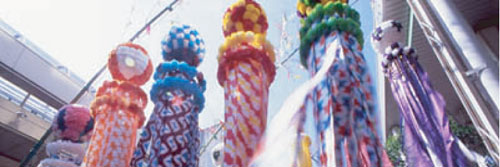


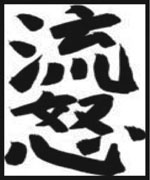
Japanese is regarded linguistically as an independent language. It has many similarities with the Altaic group of languages but has few words in common even with Korean, which is very similar grammatically, and there is no proof regarding its origins. It has many basic similarities with the languages of South-East Asia, and it used to be claimed that its parent language was Lepcha, a language from the foothills of the Himalayas. Recently, some scholars have been emphasizing its likeness to Tamil. It appears that all we can say about Japanese is that it has been formed by a fusion of a variety of cultures over the past two thousand years.
The greatest historically-recorded influence on the Japanese Language was the introduction of the Chinese writing system and Chinese culture in the seventh and eighth centuries A.D. This influence on both the written and the spoken language has continued right up to the present day, since the modern language still uses Chinese characters together with the two syllabaries hiragana and katakana, introduced in the eighth and ninth centuries and each containing forty six symbols made by abbreviating various Chinese characters. Recently, the language has become Western-influence with the introduction of Romanization. However, the Japanese sound system is far simpler than the extremely complex sound system of Chinese. Japanese has only five vowel sounds A,I, U,E and O, used on their own or with consonants to form simple syllables. The number of syllables is limited, and all end in a vowel sound except those ending with “n”, the only consonant used independently.


Sentences are usually written with a combination of Chinese characters and the hiragana syllabary, but statutes and certain other documents are written using katakana instead of hiragana. Place names and other proper nouns from the U.S.A, Europe and other areas which do not use Chinese characters, together with imported technical terms, are usually written in katakana. Approximately three thousand Chinese characters are used, but only one thousand nine hundred and forty-five, officially designated as Common-Use Characters, are used frequently.
